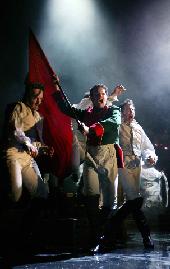SITE GUIDE
SEARCH
REVIEWS
REVIEW ARCHIVES
ADVERTISING AT CURTAINUP
FEATURES
NEWS
Etcetera and
Short Term Listings
LISTINGS
Broadway
Off-Broadway
NYC Restaurants
BOOKS and CDs
OTHER PLACES
Berkshires
London
California
New Jersey
DC
Philadelphia
Elsewhere
QUOTES
TKTS
PLAYWRIGHTS' ALBUMS
LETTERS TO EDITOR
FILM
LINKS
MISCELLANEOUS
Free Updates
Masthead
Writing for Us
A CurtainUp  London Review
London Review
 London Review
London ReviewWar and Peace
|
Pure and complete sorrow is as impossible as pure and complete joy—Tolstoy in War and Peace
|

Battle scene from War and Peace
(Photo: Robert Day) |
As you would expect from Shared Experience, the saga is portrayed not by a static narrator but by the more intangible tools of strong characterisation, impressionistic direction and electrifying original movement. Set in a space surrounded with burnished mirrors and large incomplete gilt frames, the opening sequence portrays a Russian stately home now converted into a modern day museum, explored by a tourist visitor and minded by a knitting attendant. As they discuss the history represented by the portraits on the wall, the nineteenth century cast creep onstage like a ghostly infiltration from the past. The modern ceiling lights of the museum fly upwards and the audience are transported back to the 1800s.
The beguiling promise of this dreamlike beginning is certainly not disappointed and throughout there are interesting motifs, evocative sequences and gestures redolent of meaning. For example, whenever Natasha's (Louise Ford) girlish ego is flattered, this is expressed by operatic, self-proclamatory singing. When the alluring, perfidious Anatole Kuragin (Hywel Morgan) tries to seduce her at the opera house, the couple become the opera and the misconceived romance is played out with all the high drama which Natasha must be feeling. Another recurring motif is the presence of forks and long white handkerchiefs, pointing to the twin core concepts of war and peace. However, the polarities are destabilised and intermingled, so in a ballroom, the dancers charge at each other with uplifted forks and during the Battle of Borodino, the soldiers fling their handkerchiefs as if weapons. This symbolism isn't simply for aesthetic effect as we see the war-peace boundaries obfuscated: characters enjoy the clarity of war and wrestle with the lack of tranquillity in peace.
In comparison with earlier Shared Experience productions, the physicality in War and Peace is more restrained and strictly relevant, and thus all the more effective. Instead, there is a strong focus on the characters and their inner journeys. The excellent cast manage to portray a vivid sense of emotional coherence, in spite of the changes and progressions which the characters undergo. Barnaby Kay is very sympathetic as the lovable, impressionable Pierre, hapless at times but well-meaning and idealistic. Louise Ford's Natasha has the purity and energy of Tolstoy's original and her growth into self-realisation and maturity is skilfully navigated. Katie Wimpenny is the pious and humble Maria, whose romantic yearnings are exposed by a blindfolded man dancing around her as she prays. David Sturzaker is a stern yet true Prince Andrei, Geoffrey Beevers evinces sheer geniality as Count Rostov and Jeffrey Kissoon is the irascible Prince Bolkonsky.
In addition to this rich character portrayal, Shared Experience bravely tackle the philosophical life struggles in the novel, translated to the stage via dialogue. Therefore, Pierre often converses with an imaginary Napoleon (Richard Attlee), as well as the peasant Platon Karataev (Des McAleer). In this way, the audience see his inner conflict: the quasi-hubristic attempt to control life versus an acceptance of fate and resignation to the unavoidable suffering it brings. The hint in the novel's epilogue that Pierre will be involved in the failed 1825 Decembrist revolt is elicited to more prominence in this production, so we feel that Pierre's idealism is not entirely surrendered to contented pragmatism.
This mesmeric production simply oozes humanity as the characters engagingly contend with striving, delusion, idealism and disillusion. Tolstoy is one of those rare writers who evince an absolute love for the characters he created and this is aptly translated to the stage. It could, in fact, be a blueprint for adapting complex novels onstage with its clear allegiance to the text and its beguiling, innovative direction.
|
WAR AND PEACE
Based on the novel by Leo Tolstoy Adapted by Helen Edmundson Directed by Nancy Meckler and Polly Teale With: Richard Attlee, Marion Bailey, Geoffrey Beevers, Louise Ford, Theo Herdman, Barnaby Kay, Jeffery Kissoon, Des McAleer, Hywel Morgan, Sophie Roberts, Vinette Robinson, David Sturzaker, Simon Thorp, Katie Wimpenny, Jonathan Woolf Set Design: Angela Simpson Costume Design: Yvonne Milnes Lighting: Chris Davey Music and Sound: Peter Salem Movement Director: Liz Ranken Part One running time: 3 hours with one interval Part Two running time: 2 hours and 50 minutes with one interval Box Office: 020 7722 9301 Booking to 11th May 2008 Reviewed by Charlotte Loveridge based on 14th April 2008 performance at Hampstead Theatre, Eton Avenue, London, NW3 3EU (Tube: Swiss Cottage) |
|
London Theatre Tickets Lion King Tickets Billy Elliot Tickets Mighty Boosh Tickets Mamma Mia Tickets We Will Rock You Tickets Theatre Tickets |




